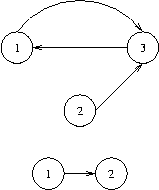题目地址:http://poj.org/problem?id=2553
The Bottom of a Graph
| Time Limit: 3000MS | Memory Limit: 65536K | |
| Total Submissions: 7881 | Accepted: 3263 |
Description
We will use the following (standard) definitions from graph theory. Let V be a nonempty and finite set, its elements being called vertices (or nodes). Let E be a subset of the Cartesian product V×V, its elements being called edges. Then G=(V,E) is called a directed graph. Let n be a positive integer, and let p=(e1,...,en) be a sequence of length n of edges ei∈E such that ei=(vi,vi+1) for a sequence of vertices (v1,...,vn+1). Then p is called a path from vertex v1 to vertex vn+1 in G and we say that vn+1 is reachable from v1, writing (v1→vn+1). Here are some new definitions. A node v in a graph G=(V,E) is called a sink, if for every node w in G that is reachable from v, v is also reachable from w. The bottom of a graph is the subset of all nodes that are sinks, i.e.,bottom(G)={v∈V|∀w∈V:(v→w)⇒(w→v)}. You have to calculate the bottom of certain graphs.
Input
The input contains several test cases, each of which corresponds to a directed graph G. Each test case starts with an integer number v, denoting the number of vertices of G=(V,E), where the vertices will be identified by the integer numbers in the set V={1,...,v}. You may assume that 1<=v<=5000. That is followed by a non-negative integer e and, thereafter, e pairs of vertex identifiers v1,w1,...,ve,we with the meaning that (vi,wi)∈E. There are no edges other than specified by these pairs. The last test case is followed by a zero.
Output
For each test case output the bottom of the specified graph on a single line. To this end, print the numbers of all nodes that are sinks in sorted order separated by a single space character. If the bottom is empty, print an empty line.

Sample Input
3 3 1 3 2 3 3 1 2 1 1 2 0
Sample Output
1 3 2
Source
【题解】:
找到入度为0的所有强连通分量,将其中的点排序后输出
这题跟poj 2186 很类似
【code】:
1 /** 2 Judge Status:Accepted Memory:1488K 3 Time:125MS Language:G++ 4 Code Length:2443B Author:cj 5 */ 6 #include<iostream> 7 #include<stdio.h> 8 #include<string.h> 9 #include<stack> 10 #include<vector> 11 #include<algorithm> 12 13 #define N 10010 14 using namespace std; 15 16 vector<int> G[N]; 17 stack<int> stk; 18 int pre[N],lowlink[N],sccno[N],scc_cnt,dfn_clock,out[N],counter[N]; 19 20 21 void DFN(int u) //tarjan算法 22 { 23 lowlink[u] = pre[u] = ++dfn_clock; 24 stk.push(u); 25 int i; 26 for(i=0;i<G[u].size();i++) 27 { 28 int v = G[u][i]; 29 if(!pre[v]) 30 { 31 DFN(v); 32 lowlink[u] = min(lowlink[u],lowlink[v]); 33 } 34 else if(!sccno[v]) 35 { 36 lowlink[u] = min(lowlink[u],pre[v]); 37 } 38 } 39 if(lowlink[u]==pre[u]) 40 { 41 scc_cnt++; //强连通图的个数标记 42 while(1) 43 { 44 int x = stk.top(); 45 stk.pop(); 46 sccno[x] = scc_cnt; 47 if(x==u) break; 48 } 49 } 50 } 51 52 void findscc(int n) 53 { 54 int i; 55 scc_cnt = dfn_clock = 0; 56 memset(pre,0,sizeof(pre)); 57 memset(lowlink,0,sizeof(lowlink)); 58 memset(sccno,0,sizeof(sccno)); 59 for(i=1;i<=n;i++) 60 if(!pre[i]) 61 DFN(i); 62 } 63 64 int main() 65 { 66 int n,m; 67 while(~scanf("%d",&n)&&n) 68 { 69 scanf("%d",&m); 70 int i; 71 for(i=1;i<=n;i++) 72 G[i].clear(); 73 for(i=0;i<m;i++) 74 { 75 int a,b; 76 scanf("%d%d",&a,&b); 77 G[a].push_back(b); // 得到图 78 } 79 findscc(n); //查找强连通图 80 int j; 81 memset(out,0,sizeof(out)); 82 memset(counter,0,sizeof(counter)); 83 84 for(i=1;i<=n;i++) //遍历一边图,查找统计个点缩点后的出度 85 { 86 for(j=0;j<G[i].size();j++) 87 { 88 int v = G[i][j]; 89 if(sccno[i]!=sccno[v]) 90 { 91 out[sccno[i]]++; //出度 92 } 93 } 94 } 95 for(i=1;i<=scc_cnt;i++) 96 { 97 if(!out[i]) //出度为0的强连通分量 98 { 99 counter[i] = 1; //标记 100 } 101 } 102 103 int pl = 0; 104 for(i=1;i<=n;i++) 105 if(counter[sccno[i]]) //是否被标记,从下到大 106 { 107 if(pl) printf(" %d",i); 108 else printf("%d",i); 109 pl = 1; 110 } 111 putchar(10); 112 } 113 return 0; 114 }